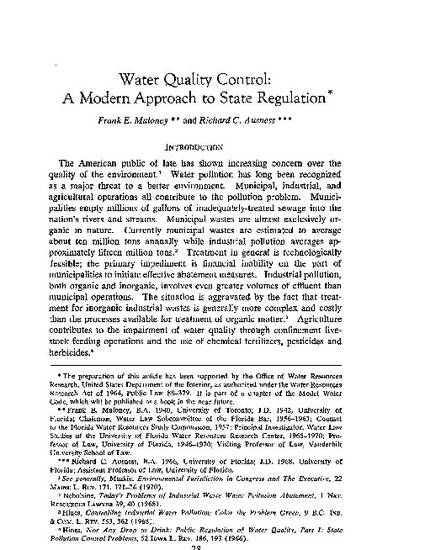
The American public of late has shown increasing concern over the quality of the environment. Water pollution has long been recognized as a major threat to a better environment. Municipal, industrial, and agricultural operations all contribute to the pollution problem. Municipalities empty millions of gallons of inadequately-treated sewage into the nation's rivers and streams. Municipal wastes are almost exclusively organic in nature. Currently municipal wastes are estimated to average about ten million tons annually while industrial pollution averages approximately fifteen million tons. Treatment in general is technologically feasible; the primary impediment is financial inability on the part of municipalities to initiate effective abatement measures. Industrial pollution, both organic and inorganic, involves even greater volumes of effluent than municipal operations. The situation is aggravated by the fact that treatment for inorganic industrial wastes is generally more complex and costly than the processes available for treatment of organic matter. Agriculture contributes to the impairment of water quality through confinement livestock feeding operations and the use of chemical fertilizers, pesticides and herbicides.
A Model Water Code has been drafted at the University of Florida in an attempt to provide a vehicle for comprehensive state regulation of water resources. The Code consists of six chapters. The first creates a two-tiered administrative system comprised of a State Water Resources Board and a number of regional water management districts administered by governing boards. This chapter also provides for a comprehensive state water plan while chapter two establishes a permit system for the regulation of consumptive uses of water. Chapter three provides for well construction standards and the licensing of the well drilling industry. Chapter four governs the construction of dams, impoundments and appurtenant works. Chapter five is concerned with water quality. Some of the prominent features of this portion of the Code are a water quality plan and the water quality standards contained therein; construction permits for new outlets, disposal systems and treatment works; discharge permits; and the various enforcement powers available to both the state and local agencies. Chapter six is an optional chapter on weather modification.
This article introduces chapter five of the proposed Model Water Code as a basis for a state program of water quality control. Although the authors have designed it as part of an overall scheme for the regulation of water use and quality under a comprehensive state water plan, this chapter can be treated in many respects as a self-contained unit and it is on this basis that chapter five is offered in this form.

Albany Law Review, Vol. 35, No. 1 (1970), pp. 28-59